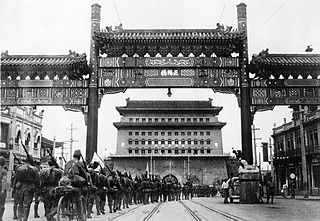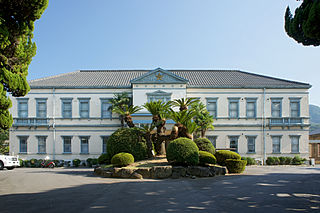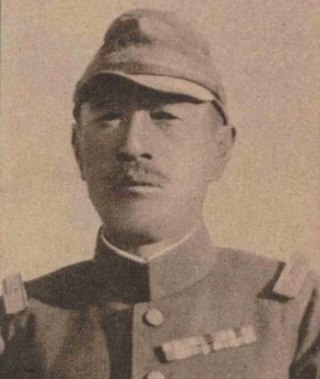Sources
This article includes a list of references, related reading, or external links, but its sources remain unclear because it lacks inline citations .(June 2016) |
The Japanese Imperial Army had Independent Infantry Brigades, which were formed as garrison units mostly in China late in World War II.
List of Japanese Imperial Army Independent Infantry Brigades
This article includes a list of references, related reading, or external links, but its sources remain unclear because it lacks inline citations .(June 2016) |

Senjūrō Hayashi was a Japanese politician and general. He served as Imperial Japanese Army Commander of the Japanese Korean Army during the Mukden Incident and the invasion of Manchuria. He briefly served as prime minister of Japan in 1937.
In Japan, the Imperial Guard is the name for two separate organizations dedicated to the protection of the Emperor of Japan and the Imperial Family, palaces and other imperial properties. The first was the Imperial guard divisions, a quasi-independent elite branch of the Imperial Japanese Army which was dissolved shortly after World War II. The second is the Imperial Guard Headquarters, a civilian law enforcement organization formed as part of the National Police Agency. (警察庁)

The Battle of Beiping–Tianjin, also known as the Battle of Beiping, Battle of Peiping, Battle of Beijing, Battle of Peiking, the Peiking–Tientsin Operation, and by the Japanese as the North China Incident was a series of battles of the Second Sino-Japanese War fought in the proximity of Beiping and Tianjin. It resulted in a Japanese victory.

Yoshinori Shirakawa was a general in the Imperial Japanese Army. He died from injuries caused by a bomb set by Korean independence activist Yun Bong-gil in Shanghai.

The Manchukuo Imperial Army was the ground force of the military of the Manchukuo, a puppet state established by Imperial Japan in Manchuria, a region of northeastern China. The force was primarily used for fighting against Communist and Nationalist guerrillas in Manchukuo but also took part in battle against the Soviet Red Army on several occasions. It initially consisted of former National Revolutionary Army troops of the "Young Marshal" Zhang Xueliang who were recruited after the Japanese invasion of Manchuria en masse, but eventually expanded to include new volunteers and conscripts. The Imperial Army increased in size from about 111,000 troops in 1933 to an estimated strength of between 170,000 and 220,000 soldiers at its peak in 1945, being composed of Han Chinese, Manchus, Mongols, Koreans, Japanese, and White Russians. Throughout its existence the majority of its troops were considered to be mostly unreliable by their Japanese officers and advisers, due to poor training and low morale.

The Empire of Japan's Kwantung Army invaded Manchuria on 18 September 1931, immediately following the Mukden Incident. At the war's end in February 1932, the Japanese established the puppet state of Manchukuo. Their occupation lasted until the success of the Soviet Union and Mongolia with the Manchurian Strategic Offensive Operation in mid-August 1945, towards the end of the Second World War.
Below is the order of battle for the Battle of Beiping-Tianjin, called the Peiking-Tientsin Operation in pinyin spelling, a series of battles fought from 25 July through 31 July 1937 as part of the Second Sino-Japanese War. It was called the North China Incident by the Japanese.

Between 1937 and 1945 the Japanese Imperial Army formed 126 Independent Mixed Brigades, typically composed of various units detached from other formations. Some were composed of separate, independent assets. These brigades were task organized under unified command and were normally used in support roles, as security, force protection, POW and internment camp guards and labor in occupied territories. An Independent Mixed Brigade had between 5,000 and 11,000 troops.

The 18th Division was an infantry division of the Imperial Japanese Army. Its tsūshōgō code name was the Chrysanthemum Division. The 18th Division was one of two infantry divisions newly raised by the Imperial Japanese Army immediately after the Russo-Japanese War (1904–1905) as part of the post war expansion of the standing Japanese military. The division received its colors on 13 November 1907. Its original headquarters was in a suburb of the city of Kurume in Fukuoka Prefecture.
7th Division was an infantry division in the Imperial Japanese Army. Its call-sign was the Bear Division.

The 11th Division was an infantry division in the Imperial Japanese Army. Its tsūshōgō code name was the Brocade Division, and its military symbol was 11D. The 11th Division was one of six infantry divisions newly raised by the Imperial Japanese Army after the First Sino-Japanese War (1894–1895). The division received its colors on 1 October 1898 and was disbanded in September 1945. Its troops were recruited primarily from communities in the four prefectures of the island of Shikoku. It was originally headquartered in the city of Zentsuji, Kagawa, and its first commander was Lieutenant General Nogi Maresuke.
The 26th Division was an infantry division in the Imperial Japanese Army. Its call sign was the Spring Division. The 26th Division was raised 30 September 1937 out of the three independent infantry regiments from the original 11th Independent Mixed Brigade and reserve components from various divisions based in Manchukuo. It has the distinction of being the first Japanese triangular division.
The Japanese 13th Army was an army of the Imperial Japanese Army during the Second Sino-Japanese War and World War II.
The Japanese 21st Army was an army of the Imperial Japanese Army during the Second Sino-Japanese War.
The 114th Division was an infantry division of the Imperial Japanese Army. Its call sign was Commander Division. It was formed on 12 October 1937 in Utsunomiya, Tochigi as a B-class square division. The nucleus for the formation was the 14th Division headquarters. It was originally subordinated to the Central China Area Army.

Norihide Abe was a career officer and Lieutenant General in the Imperial Japanese Army who was the most senior Japanese officer killed in combat during the Second Sino-Japanese War.
The 58th Division was an infantry division of the Imperial Japanese Army. Its call sign was the Wide Division. It was formed on 2 February 1942 in Hankou as a security division, simultaneously with the 59th and 60th divisions. The nucleus for the formation was the 18th Independent Mixed Brigade. Also, many of the soldiers of the 136th Infantry Brigade of the 106th Division, demobilized in 1940, were re-employed in the 58th Division. As a security division, the 58th Division's backbone consisted of independent infantry battalions, and it did not include an artillery regiment.
The 62nd Division was an infantry division of the Imperial Japanese Army. Its call sign was the Stone Division. It was formed on 1 May 1943 in Taiyuan, simultaneously with the 63rd Division as a security division. The nucleus for the formation was the 4th and a part of the 6th Independent Mixed Brigades. As a security division, it lacked an artillery regiment. The division was initially assigned to the 1st Army.
The 104th Division was an infantry division of the Imperial Japanese Army. Its call sign was the Phoenix Division. It was formed 16 June 1938 in Osaka as a B-class square division. The nucleus for the formation was the 4th division headquarters. The division was originally subordinated to the Northern China Area Army.
The 69th Division was an infantry division of the Imperial Japanese Army. Its call sign was the Winning Division. It was formed on 2 February 1942 in Linfen city as a class C (security) division, simultaneously with the 68th and 70th divisions. The backbone of security division has consisted of the eight independent infantry battalions, and it does not have an artillery regiment. The nucleus for the formation was the 16th Independent mixed brigade and a reservists from the former 108th division, recruited from Hirosaki mobilization district.